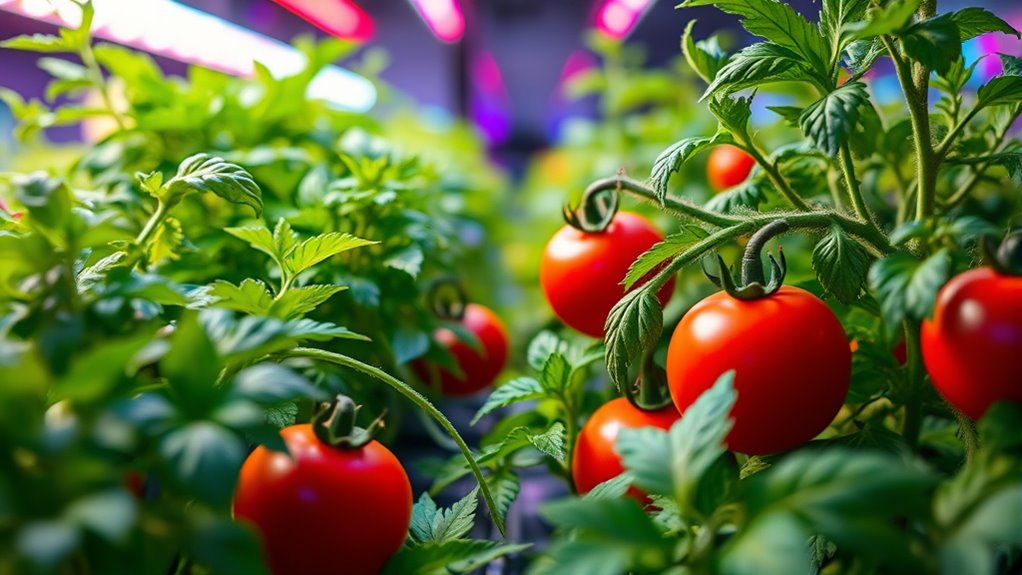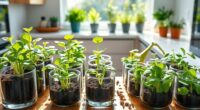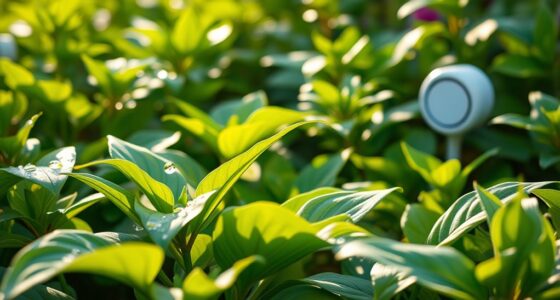To choose the right LED spectrum for herbs, greens, and tomatoes, focus on providing specific wavelengths that match each plant’s needs. Use plenty of blue light to promote healthy leaves and nutrient uptake, and add red light to support flowering and fruiting. Balance these wavelengths throughout growth stages and adjust intensity for ideal results. Keep exploring to discover how fine-tuning your setup can boost plant health and yields even further.
Key Takeaways
- Match blue-heavy spectra for herbs and greens to boost nutrient uptake and compact foliage growth.
- Use a balanced mix of red and blue light to optimize tomato vegetative growth and flowering phases.
- Adjust spectrum during growth stages, increasing red light during flowering for higher yields.
- Ensure high CRI LEDs for accurate plant health assessment and precise spectrum delivery.
- Incorporate adjustable dimming and coverage controls for tailored light intensity and distribution.
Understanding Light Spectrums and Plant Needs

Understanding light spectrums is essential because plants rely on specific wavelengths for ideal growth. You need to know how different light color temperatures influence photosynthesis efficiency, which directly impacts plant health. Blue light, with its cooler temperature, promotes compact, leafy growth, while warmer red and orange hues encourage flowering and fruiting. Recognizing how these spectra align with your plants’ needs helps you optimize their development. The right balance of light wavelengths ensures that photosynthesis operates at maximum efficiency, providing the energy plants need to grow strong. Additionally, light spectrum accuracy plays a vital role in ensuring plants receive the precise wavelengths for optimal growth, leading to healthier and more productive plants. By understanding the connection between light spectrum and plant response, you can select LED lighting that enhances growth rates and yields. This knowledge empowers you to create a tailored environment that supports your herbs, greens, or tomatoes effectively.
Tailoring LED Spectra for Herbs and Greens
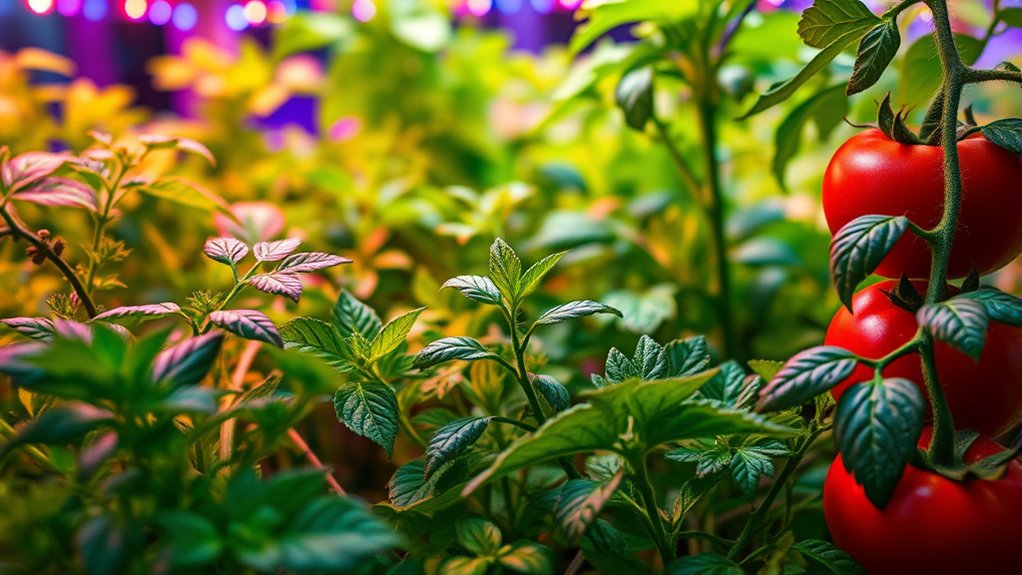
To maximize growth for herbs and greens, tailoring LED spectra involves selecting the right combination of light wavelengths that meet their specific needs. Focus on providing a spectrum rich in blue light, which enhances plant nutrient uptake and promotes compact, healthy foliage. Blue light improves photosynthesis efficiency, enabling plants to convert light into energy more effectively. Incorporate a moderate amount of red light to support stem elongation and overall vigor without overstimulating growth. Green wavelengths can also be included, as they penetrate deeper into the canopy, benefiting lower leaves. Additionally, understanding light spectrum balance is crucial for customizing your LED setup to optimize plant health. By customizing your LED spectrum to balance these wavelengths, you guarantee your herbs and greens receive optimal light for nutrient absorption and efficient photosynthesis, leading to lush, healthy growth.
Optimizing Light for Tomato Growth and Fruiting
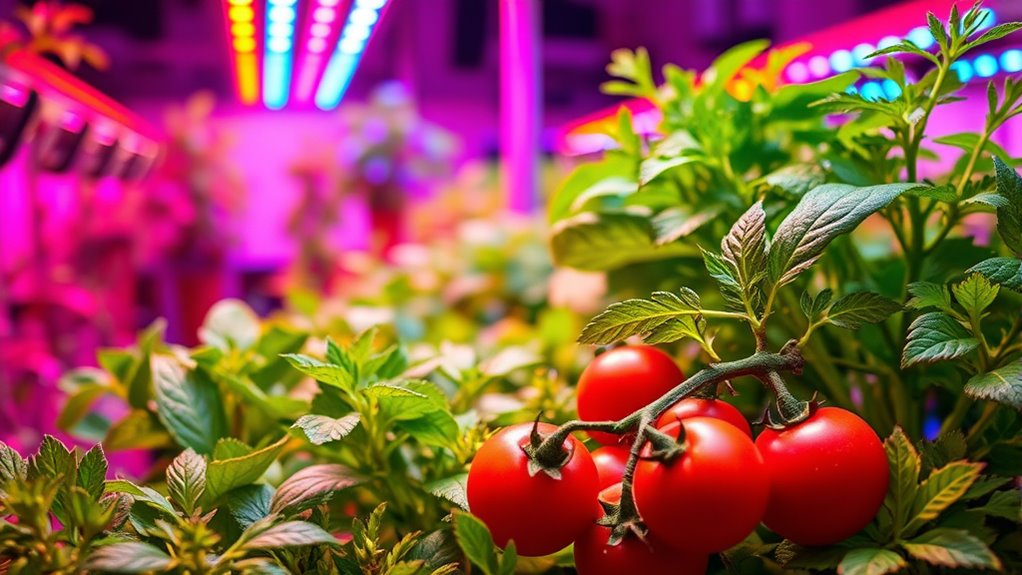
Enhancing light for tomato growth and fruiting requires a strategic combination of wavelengths that promote both vegetative development and fruit production. Your LED spectrum should include blue light to enhance plant photosynthesis and strengthen foliage, ensuring healthy plant structure. Incorporate red light, especially in the 600-700 nm range, to stimulate flowering and fruiting processes. A balanced spectrum encourages robust vegetative growth initially, then shifts toward wavelengths that support flowering and fruit development. Proper spectrum selection helps maximize photosynthesis efficiency, leading to healthier, more productive tomato plants. Additionally, understanding light spectrum optimization can help you tailor your setup for maximum yield. By tailoring your LED lighting to these specific light qualities, you’ll create an environment that fosters optimal growth and abundant fruiting, ensuring your tomatoes reach their full potential.
Balancing Light Intensity and Duration for Best Results
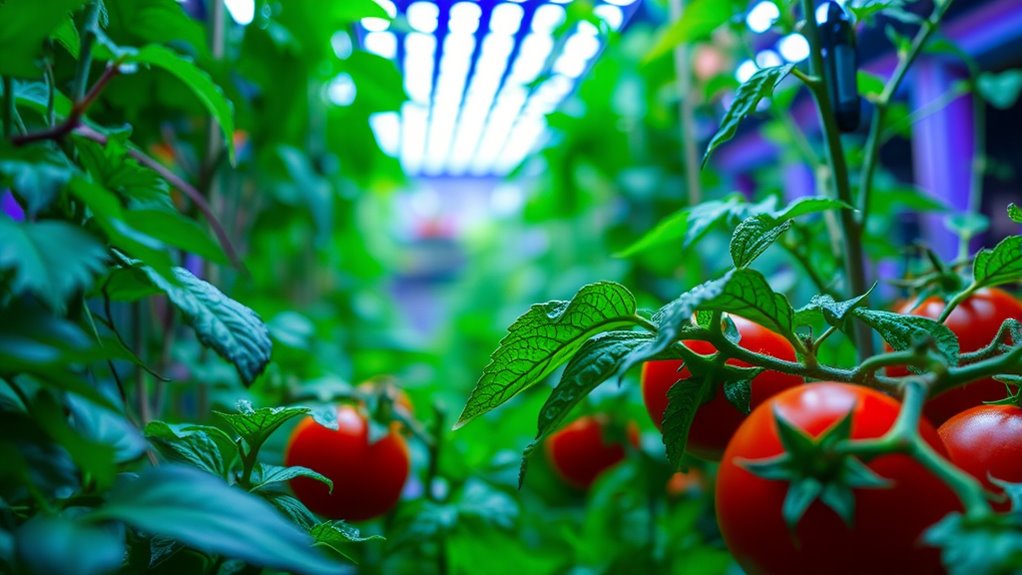
Balancing light intensity and duration is essential for maximizing tomato growth and fruiting. Too much light intensity can cause stress, while insufficient light limits development. Similarly, adjusting light duration ensures plants receive adequate energy without overexposure. To optimize results, consider these factors: 1. Set light intensity based on plant stage—higher during flowering, lower during vegetative growth. 2. Maintain consistent light duration—generally 12-16 hours per day for tomatoes. 3. Monitor plant response regularly, modifying both light intensity and duration to prevent stress or deficiencies. Additionally, paying attention to natural materials like wood and linen can help create a comfortable environment that supports healthy plant growth.
Tips for Selecting and Adjusting Your LED Setup
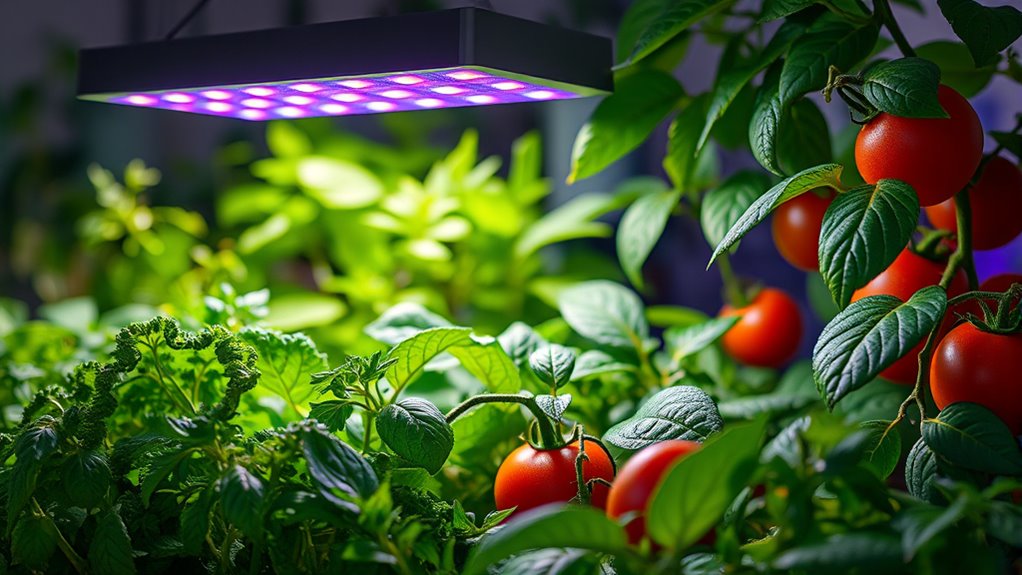
Choosing the right LED setup begins with understanding your plants’ specific needs and your growing environment. To minimize light pollution, select fixtures with focused beams and adjustable settings, guaranteeing light stays within your grow space. Pay attention to color rendering; a high color rendering index (CRI) helps you accurately gauge plant health and growth stages. Adjust your LEDs to provide the ideal spectrum for herbs, greens, or tomatoes, shifting between vegetative and flowering phases. Consider dimming options and the ability to modify light intensity and duration. Proper placement also matters—position lights to avoid overlap and ensure even coverage. Regularly monitor plant response and tweak settings accordingly. Incorporating Pimple Patches into your routine can also help keep your skin healthy during intense growing periods. This approach maximizes growth, conserves energy, and reduces unwanted light spill, creating an efficient, plant-friendly environment.
Frequently Asked Questions
How Does LED Light Spectrum Affect Plant Nutrient Content?
You might wonder how LED light spectrum influences plant nutrient content. The spectrum affects photosynthesis efficiency, which in turn impacts how well plants produce energy. A tailored spectrum can boost nutrient density by encouraging ideal growth and metabolic processes. When you choose the right LED spectrum, you’re helping your plants maximize nutrient uptake, resulting in healthier, more nutritious herbs, greens, and tomatoes.
Can LED Lighting Influence Pest Resistance in Herbs and Greens?
In a bygone era, folks relied on natural pest deterrent strategies, but today, LED lighting can also influence pest resistance. You can enhance plant immune response by adjusting light spectra, making herbs and greens less appealing to pests. Proper LED setup may reduce the need for chemical defenses, boosting plant health and resilience. So, yes, your lighting choices can help fortify your plants against pests naturally.
What Are the Energy Savings of LED Lights Versus Traditional Grow Lights?
You’ll find that LED lights offer significant energy savings compared to traditional grow lights. Their cost analysis shows lower electricity bills due to higher efficiency and longer lifespan. Over the long term, these savings add up, making LEDs a cost-effective choice for your grow setup. Plus, they generate less heat, reducing cooling costs, so you enjoy more consistent growth with fewer expenses.
How Do I Prevent Light Pollution From Indoor Grow Setups?
To prevent light spillage from your indoor grow setup, you should use grow area shielding like reflective hoods or barriers that block excess light. Make certain your grow lights are properly directed downward and fitted with adjustable hoods to contain the light within your designated space. Regularly check for gaps or leaks, and consider using blackout curtains or additional barriers to further minimize light pollution, keeping your neighbors happy.
Are There Specific LED Brands Recommended for Small-Scale Growers?
When choosing LED brands for small-scale growing, look for options with a strong reputation for quality and reliability. Brands like Spider Farmer, Mars Hydro, and Viparspectra are popular because they balance cost-effectiveness with proven performance. You want lights that last, provide good spectrum coverage, and fit your budget. Doing some research on user reviews and product specs can help you find the best brand to meet your needs and guarantee healthy growth.
Conclusion
By choosing the right LED spectrum, you’ll transform your grow space into a vibrant jungle, where herbs thrive with lush green leaves, greens burst with fresh energy, and tomatoes ripen to perfect red. Imagine the warm glow illuminating your plants’ every leaf and fruit, fueling their growth and flavor. With the right setup and adjustments, you’ll create a thriving indoor garden—bountiful, beautiful, and bursting with life—right in your own home.
